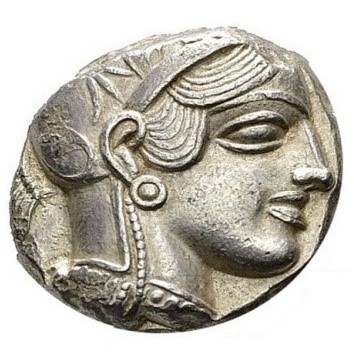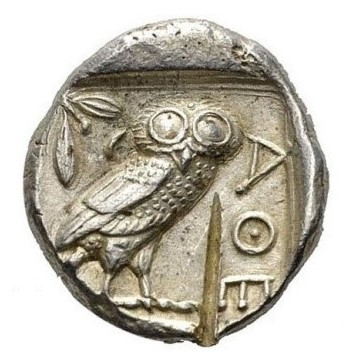Title: Tetradrachmon of Athens - 2014.02
Acquisition number: 2014.02
Author or editor: Hugh Preston
Culture or period: Classical Greece.
Date: c. 430 BC.
Material: Metal - Silver
Object type: Coins - Greek
Origin region or location: Greece
Origin city: Athens.
Display case or on loan: 5
Keywords: Coin, Greek, tetradrachmon, Athena, Laurion
Sylloge Nummorum Graecorum, Copenhagen, The Royal Collection of Coins and Medals, Danish National Museum, repr. edn (West Milford, NJ, 1981-), 31-40.
SNG Munich = Sylloge Nummorum Graecorum, Deutschland, München Staatlische Münzsammlung (Berlin, Hirmer Verlag, 1968-), 46-59.
2014.02
Tetradrachmon of Athens
Silver 16.60 g. c. 430 BC
Obv.: Head of Athena r., wearing decorated Attic helmet.
Rev.: Owl r., head front, crescent and olive spray behind to left, ΑΘΕ (abbrev. for ΑΘΗΝΑΙΩΝ, ‘of the Athenians’) to right, all within incuse square.
Coins known as Athenian ‘Owls’ were high relief coins with the helmeted head of Athena on the obverse and an owl standing right on the reverse. They were first struck at the end of the sixth century BC, at about the same time as the establishment of Athenian democracy under Kleisthenes. These coins evolved during the second half of the fifth century to become increasingly elegant. An odd feature of all ‘old’ Owls is that the chunky flan is too small to accommodate the entire image on the dies. This does not seem to have been an issue for the moneyers, who were probably more concerned with getting the weight right.
The source of silver was the Laurion mines near Athens, thought to have been first exploited c. 520 BC. After the discovery of new deposits c. 483 BC, silver was used to significantly increase the production of Owls for building up the Athenian navy in preparation for the anticipated Persian invasion of Greece. Laurion silver in ancient times had a reputation for its high quality. According to modern metallurgical testing, Owls in general have a very high silver content, lower in copper (as well as gold) compared with other ancient silver coins. This means that relatively few Owls are crystallized, a condition that seems to be related to naturally occurring lead or copper contaminants.
Athenian silver coins played the role of an international currency through the fifth and part of the fourth centuries BC. For a period from (probably) the 420s, Athens forced its allies to use Athenian coins. But even after Athens' loss of its empire at the end of the Peloponnesian War (431–404 BC), its coins continued to enjoy the status of a trusted international currency. Silver production at Laurion continued to have economic importance in the fourth century.
This piece exhibits a test cut on the reverse. It would have been made to ensure that the piece was solid silver rather than silver-plated. In the fourth century test cuts in coins became quite common, particularly those that have been found in Middle Eastern hoards. It is quite difficult to distinguish fourth-century Athenian Owls from copies struck in the Greek East. (See, for example, Peter van Alfen, American Journal of Numismatics, vol. 16-17 (2004–05), pp. 47-61).
The planchets (blanks) of classical Owls appear to have been produced by pouring molten silver into open moulds designed to hold the correct amount of metal. This resulted in thick flans of irregular shape. With most ancient coins, the obverse die was placed in an anvil under the planchet, and the reverse die was held above the planchet and struck by hand with a heavy hammer. This caused reverse dies to wear out sooner than obverse dies.
Sylloge Nummorum Graecorum, Copenhagen, The Royal Collection of Coins and Medals, Danish National Museum, repr. edn (West Milford, NJ, 1981-), 31-40.
SNG Munich = Sylloge Nummorum Graecorum, Deutschland, München Staatlische Münzsammlung (Berlin, Hirmer Verlag, 1968-), 46-59.

